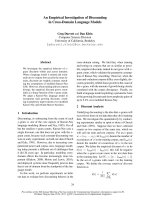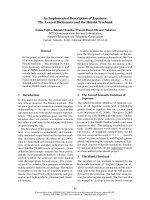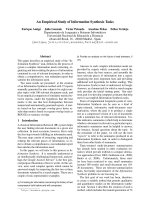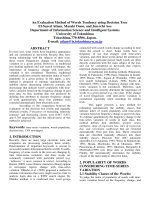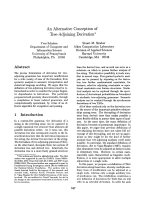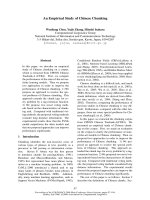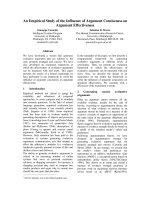Báo cáo khoa học: "AN EXPERIFENTON SYNTHESIS OF RUSSIAN PARAMETRIC CONSTRUCTIONS" potx
Bạn đang xem bản rút gọn của tài liệu. Xem và tải ngay bản đầy đủ của tài liệu tại đây (306.56 KB, 4 trang )
AN EXPERI~FENTON SYNTHESIS OF RUSSIAN PARAMETRIC CONSTRUCTIONS
I.S. Kononenko, E.L. Pershina
AI Laboratory, Computing Center,
Siberian Branch of the USSR Ac. Sci.,
Novosibirsk 630090, USSR
ABSTRACT
The paper describes an experimental
model of syntactic structure generation
starting from the limited fragment of se-
mantics that deals with the quantitative
values of object parameters. To present
the input information the basic semantic
units of four types are proposed:"object",
"parameter", "function" and "constant".
For the syntactic structure representation
the system of syntactic components is used
that combines the properties of the depen-
dency and constituent systems: the syntac-
tic components corresponding to wordforms
and exocentric constituents are introduced
and two basic subordinate relations ("ac-
tant" and "attributive") are claimed to be
necessary. Special attention has been de-
voted to problems of complex correspon-
dence between the semantic units and lexi-
cal-syntactic means, In the process of
synthesis such sections of the model as
the lexicon, the syntactic structure gene-
ration rules, the set of syntactic restric-
tions and morphological operators are uti-
lized to generate the considerable enough
subset of Russian parametric constructions.
I INTRODUCTION
The semantics of Russian parametric
constructions deals with the quantitative
values of object parameters. The paramet-
ric information is more or les~ easily ex-
plicated by means of basic semantic units
of four types: "object" ('table', 'boy'),
"parameter" ('weight', 'length', 'age'),
"function" ('more', 'equal', 'almost equal')
and "constant" ('two meters', 'from 3 to 5
years').
In simple situations each of these
units is separately realized in a lexeme
or a phrase, their combinations forming
full expressions with the given sense:
malchik vesit bolshe dvadcati kilogrammov
'boy weights more than twenty kilograms'.
It is precisely these direct and simple
means of expressions that are usually used
in systems generating natural language
texts.
Natural languages, however, operate
with more complex means of expression ;
one-to-one correspondence between semantic
units and lexical items is not always the
case. The complex situations are suggested
here to be explained in terms of decompo-
sition of the input semantic representa-
tion (cf. the notion of form-reduction
in Bergelson and Kibrik (1980)). This phe-
nomenon is exemplified by such Russian le-
xemes as stometrovka 'hundred-meters-long-
distance' which semantically incorporates
the four constituents of the parametric
semantics.
As an ideal, a language model should
embrace mechanisms that provide generation
and understanding of the constructions
that make use of the various possibilities
of lexicalization and grammaticalization
of sense. The presented model deals with
some aspects-of the phenomena that have
not been Considered before: all the possi-
bilities of decomposition of the input in-
formation are taken into account and the
means of syntactic structure representa-
tion are developed to provide the synthe-
sis of the parametric syntactic structure.
The paper is organized as follows.
In section 2 the set of semantic components
is described. In section 3 the relevant
syntactic notions are introduced. In sec-
tion 4 the process of synthesis is outlin-
ed, followed by conclusions in section 5.
2 SE~IANTIC COMPONENTS
The information to-be-communicated is
represented as a set of four semantic
units each of them being marked with the
type-symbol (o - "object", p - "parameter",
f - "function", c - "constant").
At the initial step of synthesis a
process involving the decomposition of the
input semantic structure into a system of
semantic components takes place. Usually,
a semantic structure corresponds to seve-
ral decompositions. The forming of a com-
ponent may be motivated by the following
reasons.
129
In the event of separate lexicaliza-
tion a componen~ represents exac~±y one
semantic unit. There are four components
of this kind according to the number of
unit types. So, the object component K
o
represents a unit of the "object" type and
is realized in a noun (dom 'house') or a
possessive adjective (papin 'father's').
The parameter component Kp is lexicalized
in parametric nouns, verbs and particip-
les. The function component Kf is realiz-
ed in lexemes of different syntactic clas-
ses: prepositions, comparative verbs and
participles and forms of comparative de-
gree of some adjectives and adverbs. The
constant component K c corresponds to mea-
sure adjectives and some quantitative con-
structions described in Kononenko et al.
(1980).
A component represents more than one
semantic unit in two situations.
(1) The first one has been mentioned
above. It concerns the phenomenon of in-
corporation of several units in one lexe-
me: thus, the component Kopfc is intro-
duced to account for the lexemes like sto-
metrovka and Kpf component is a proto-
type of parametric-comparative adverbs
like shire 'wider'.
(2) On the other hand, the introduc-
tion of a component may be connected with
the fact that a certain unit is not lexi-
calized at all. Such "reduced" elements of
sense are considered to be realized on the
surface by the type of the syntactic struc-
ture composed of the lexicalized units of
the component. For example, in Russian ap-
proximative constructions litrov pjat
'about-five-liters' it is only the "cons-
tant" unit that is lexicalized and the
unit of the "function" type ('almost equal)
is expressed by purelysyntactic means,
i.e. the inverted word-order in the quan-
titative phrase. The corresponding compo-
nent represents both the "function" and
"constant" units.
3 SYNTACTIC STRUCTURES
The syntactic structures of Russian
parametric constructions are various
enough. The full system of rules (Kononen-
ko and Pershina, 1982) provides the gene-
ration of nominal phrases and simple sen-
tences but the structures within the comp-
lex sentence such as komnata, dlina koto-
rojj ravna pjati metr~n 'room whoso length
is five meters' are left out of account.
So, the model allows for the following ex-
amples: shestiletnijj malchik 'six-years-
old boy'; bashnja vysotojj bolee sta metrov
'tower of more than hundred meters height';
kniga stoit pjat rublejj 'book costs five
roubles' etc.
To represent the syntactic structures
the system of syntactic components sugges-
ted in Narinyani (1978) proved to be use-
ful, that combines the properties of the
dependency and constituent systems. ~vo
different types of syntactic components,
the elementary and non-elementary ones,
are claimed to be necessary. The elementa-
ry component corresponds to a wordform
and is traditionally represented by a le-
xeme symbol marked with syntactic and mor-
phological features.
The non-elementary component is com-
posed of syntactically related elementary
components. The outer syntactic relations
of the non-elementary component cannot be
described in terms of syntactic and mor-
phological characteristics of the consti-
tuent elementary components. The notion of
a non-elementary component is a convenient
tool for describing the syntactic behavi-
our of Russian quantitative constructions
composed of a noun and a numeral: the mor-
phological features of the subject quanti-
tative phrase (nominative, plural) are not
equivalent to those of the nominal consti-
tuent (genitive, singular).
The minimal syntactic structure that
is not equal to a wordform is described
in terms of a syntagm, i.e. a bipartite
pattern in which syntactic components are
connected by an actant or attributive syn-
tactic relation. Each component is marked
with the relevant syntactic and morpholo-
gical features.
The actant relation holds within the
attern in which the predicate component
governs the form of the actant component
Y, e.g.: shirina [XJ ehkrana [Y] 'width
of-screen' the governing lexeme shirina
determines the genitive of the noun-ac-
tant.
The attributive relation connects the
component X with its syntactic modifier,
or attribute, Y. The attributive synta~u
is typically composed of a noun and an ad-
jective (stometrovaja [YJ vysota [X] 'one-
hundred-meters height'), a noun ~id a par-
ticiple, a noun and another noun, a verb
and an adverb or a preposition.
The syntactic relation is represented
by an'%ct" or "attr" arrow leading from X
to Y.
The syntactic class features reflect
the combinatorial properties of the compo-
nents in the constructions under conside-
ration. The following are some examples of
the syntactic features:
"S " - object nouns (dom 'house')
obj
130
"S " - parametric nouns
param (yes %veight')
"A " - possessive adjectives
poss (papin 'father's')
'|V f'
param - parametric verbs
(stoit 'to-cost')
"P " - parametric participles
param (vesjashhijj 'weighing')
"A " - measure adjectives
meas (pjatiletnijj 'five-years-
old')
The syntactic structure does not con-
tain any syntactically motivated morpholo-
gical features connected with government
or agreement (the latter are described se-
parately in the morphological operators
section of the model). The case of the
noun used as attribute is reflected in the
syntactic structure representation since
this feature is relevant in distinguish-
ing syntagms.
(e)
Sobj
(f)
Sobj
act V malchik vesit 'boy
param weights'
act S vysota doma 'height
param of-house'
The rules applicable to different
fragments of the same decomposition are
bound with the syntagmatic restrictions
that prevent the unacceptable combinations
of syntagms. Thu~ the combination of the
syntagm (c) for {K_, K } and the adjective
lexicalization of ~he ~onstant" component
forms the unacceptable syntactic structure
~ehkran pjatimetrovojj shirinojj 'screen
of 5-meters-long width (instr)'.
The process of synthesis yields all
the possible syntactic structures corres-
ponding to the input semantic representa-
tion.
4 STRUCTURE GENERATION
5 CONCLUSION
The first step of synthesis is the
decomposition of the input semantic repre-
sentation into the set of semantic compo-
nents. The possibilities of lexicalization
of components are determined by the lexi-
con that provides every lexeme with its
semantic prototype - the set of semantic
units incorporated in the meaning of the
lexeme. The lexicalization rules replace
the semantic components b~ the concrete
lexemes, e.g.:'weight' ~K~ is replaced
P
by the lexemes yes IS ~ ~, vesit[V ]
or vesjashhijj [Pparl]~ ~
The semantic types of components de-
termine their combinatorial properties on
the syntactic level. T~le grammar is deve-
loped as the set of rules each of which
provides all the syntagms realizing the
initial pair of components.
For example, the pair ~Ko, Kp~ corres-
ponds to six syntagms:
(a)
A attr S
poss param papin yes 'father's
weight'
Cb~
attr
Sobj " Sparam,gen ehkran shiriny
'screen of-
width (gen)'
(c) attr
Sobj ~ Sparam,instr bashnja vyso-
tojj 'tower
of height
(instr.)'
(d)
attr kniga stojashhaja
Sobj
Pparam 'book costing'
In this report on the basis of the
very limited data of the parametric const-
ructions an attempt has been made to con-
sider a simplified model of synthesis of
the text expression beginning from the gi-
ven semantic representation. The scheme
presented above is planned to be implement-
ed within the framework of the question-
answering system.
Right from the start of synthesis the
process of decomposition of the input se-
mantics takes place in order to capture
different cases of complex correspondence
between the semantic units and the lexical
-syntactic means. To generate the conside-
rable enough subset of Russian parametric
constructions such sections of the lang-
uage model as the lexicon, the grammar ge-
nerating the syntactic structures, the
set of syntactic restictions and morpholo-
gical operators are utilized. The listed
constituents, however, do not, exhaust all
the necessary mechanism of synthesis
since the problems of word-order are left
to be investigated and an additional refe-
rence to various aspects of the communica-
tive setting is required. We believe that
being of primary ~nportance for automatic
synthesis of natural language texts the
communicative aspect of text generation
presents one of the mo~t promising research
directions for future a~tivity.
131
6 REFERENCES
Bergelson, M.B.; Kibrik, A.E., 1980.
"Towards the General Theory of Language
Reduction". In: ~ormal Description of
Natural Language Structure. pp. 147-161.
Novosibirsk (in Russian).
Kononenko, I.S.; Y~asnova, V.A.; Pershi-
na, E.L., 1980. The Structure of Russ-
ian Quantitative Constructions. Prep-
rint No. 237. Novosibirsk (in Russian).
Kononenko, I.S.; Pershina, E.L., 1982.
A ~odel Generating Syntactic Structures
of Some Russian Parametric Constructions.
In: Formal Representation of Linguistic
Information. pp. 103-122. Novosibirsk
(in Russian).
Narinyani, A.S. 1978. Formal ~odel: Gene-
ral Scheme and Choice of Adequate Means.
PrePrint No. 107. Novosibirsk (in Rus-
sian ).
132

